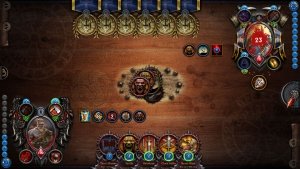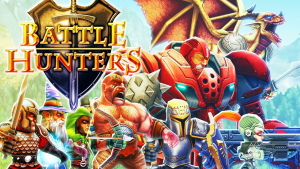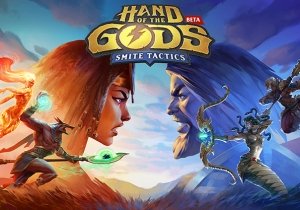Hand of the Gods: Smite Tactics – First Look
Hand of the Gods, formerly just Smite Tactics, has undergone some serious changes since I first played the Alpha version at Smite World Championships back in January of this year. With a myriad of card games flooding the market, it could be tough for Hi-Rez to carve their niche. Still, I’m a huge fan of Smite so I really want to see the game succeed. But how is it coming along?
Hand of the Gods is a hybrid Card-Game Strategy RPG in the same vein as Pox Nora that we reviewed last week, and genre standout Duelyst. Originally, the game played a lot more like Duelyst, with your leader being a moveable unit on the board in addition to all the other units you could play. Since the re-branding and design overhaul, the game has shifted away from that. Now your leader stands on the sidelines, looming over the battlefield much as you would expect a major god to do. The god’s weak point is represented by a stationary glowing gem on the board that your enemies can attack with spells and monsters to damage you. First to kill the opponent’s gem wins. There are a lot of minions, gods, and spells you can play that will be all too familiar to any fans of Smite. Building a deck isn’t terribly difficult since the card pool is still relatively small and cards are limited to two copies per deck. You can only have 25 cards in your deck, so building something that is viable will be easier on new players, but optimizing your deck is still a fun challenge for card game veterans. The game strikes a good balance between deck structure and execution on the battlefield; just because you have the best cards doesn’t mean that you know how or when to use them. There are a lot of different leaders to pick from and more are being added over time (as well as more factions) so you have a ton of options. I personally enjoy Freya; Norse is my favorite faction from Smite, and Freya’s ability to remove a creature from play for a turn synergizes well with Norse’s strongest strategy which is to rush down your opponent with small to mid-size creatures and pumping them up with spells at the right moment. If you’re more of a control or tempo player, you will want to look at Egyptian and Greek decks as they excel at mid range board control and powerful late-game minions and gods. I haven’t encountered or experimented with Chinese decks either, so I’m not sure what their focus is. They’re still relatively new to the game so I’m sure they’ll pick up steam soon.
The game feels a lot more balanced than it did in its alpha phase and that was one of the big turnoffs for me. It can be tricky to balance a card game but Hi-Rez has done a great job tweaking the game into a fun, fast paced strategy game that has yet to present me with a match that felt like it was unwinnable or broken. In fact, rounds are way faster than they were in the alpha, likely owing the seemingly smaller grid size and the removal of Leaders as moveable units. Creatures seem to move more squares at a time as well than they did before, but that may just be my memory being a bit faulty. Either way, the pacing is fun, quick and ensures that win lose or draw you won’t be in a match for too long. This allows for more games to be played in a set time, allowing you to accrue favor and complete more quests quickly.
Hand of the Gods does have its problems, but they’re few and far between. The dynamic background on the main menu always seems to lock up when loading, making the process of getting into the game take far longer than it should. Also, the UI seems rather bland now when you compare it to the minimal but appealing UI of games like Paladins, or the very architectural and stylized UI of Paladins. The look of the menus and interface just feel bland and uninteresting. Also, there are problems with card text not loading properly when cards are in your hand; also, mousing over your cards while in a game sometimes makes your hand behave in strange ways making it difficult to tell which card you’re about to click on. This can cause misplays and should be addressed as soon as possible. This only happened some of the time though and these issues would be easy to fix moving forward.
Aside from the game-play, the rest of the offering made by Hand of the Gods is standard CCG stuff. You get Favor for completing matches, you spend the favor on packs. You disenchant the cards you don’t want or need and use the dust to craft other cards that you do want. It takes 300 favor to get a pack, and matches award as much as 150 favor per win in the early stages. Additionally, there are quests you can complete that give favor in the hundreds as well so getting packs without spending money is very easy. Given the somewhat small card pool, it won’t be hard to assemble a nice collection of cards without dropping money. If you want to spend money though, you absolutely can. Runes are the real-world currency. 500 gems get you 7 packs, 1000 gems will get you 15 packs, 2500 gems get you 40 packs, and 3500 gems gets you 60 packs. There’s also a founder’s bundle you can buy that gives you bonus stuff. To break that down, the 7 pack bundle costs 13* dollars. That comes to about 60 cents a pack. Not bad compared to other card games I’ve reviewed where packs cost as much as 2 dollars or more. You can save money by buying the larger bundles, but the savings are marginal. These are mostly convenience purchases. As I mentioned earlier it’s super easy to build a collection without spending money and the smaller card pool means it takes less time to build a competitively viable deck.
All in all, Hand of the Gods is a tremendously fun card game that takes the formula established by Duelyst, simplifies it a bit more, and adds the charm and mythological focus of Smite that fans already know and love. The game offers a fast way to get caught up and build a collection of cards and is very wary about avoiding the pay-to-win pitfalls that plague so many card games today. If you like card games, strategy games, or mythology in general, Hand of the Gods is a must play.
Videos You May Enjoy
Articles You May Enjoy
- Lineage 2's 'Prelude of War' Update Launches on 4game
- This update allows a player a random chance to become a raid boss and loot 10 billion Adena. Now that's exciting!
- Square Enix's Mobile Titles Begin Valentine's Day Promotion
- Square Enix began their limited-time Valentine's Day themed events across Star Ocean: Anamnesis, Mobius Final Fantasy, and FF Brave Exviu...
- Final Fantasy XIV ARR: HEAVENSWARD Pre-orders Now Available
- Square Enix, Inc. announced today that FINAL FANTASY® XIV: Heavensward™, the highly-anticipated first expansion for the popular MMORPG, is ...












